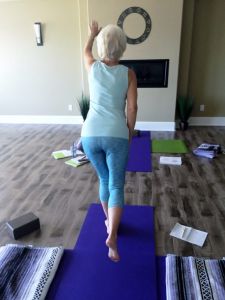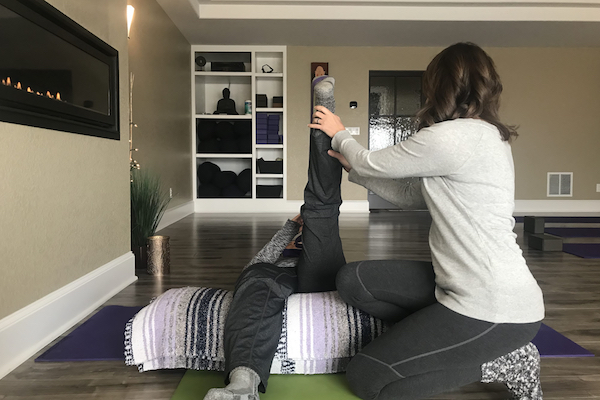Written by Nancy Levenson
If you want to untie a knot, you must look at the cords carefully, then gently undo the tangle. Yanking on the cords will only make the knot tighter.
– Thomas Hanna
You’ve just been told by your neurologist or doctor that they suspect you have Parkinson’s. What started out as a desire to understand some physical changes you were experiencing - a small tremor, tired muscles, a little imbalance when walking - has now crossed over into something more complex, and you may begin to feel a knot forming inside you.
People who are initially diagnosed with Parkinson’s quickly discover that Parkinson’s reaches beyond just the physical and impacts the energetic, emotional, social and spiritual aspects of your life as well - ensnaring all of these cords of wellness. And, because Parkinson’s affects the Autonomic Nervous System (ANS), it impacts other systems of the body such as the digestive, muscular, eliminatory and respiratory systems as well.
Most people Parkinson’s internalize their mounting anxiety and that causes additional problems like stress, fatigue and depression. The early days and weeks after diagnosis prompt difficult questions that in most cases result in answers that bring on even more anxiety and stress. Then fear begins to creep into the picture, tightening the internal knots even more. Breathing and sleep patterns begin to change, and you may begin to witness a withdrawal from the things that you love.
This is all a normal cycle of consuming and digesting the current symptoms and imagining a potential future with Parkinson’s, and you may be at a loss of how to start the process of dealing with all of it.
One growing area of support for people living with Parkinson’s is Yoga Therapy. Yoga therapy differs from what most Westerners consider yoga and supports clients with an integrative and customized approach to their diagnosis and wellness plan.
While many “poses” of yoga have a therapeutic effect, this alone does not qualify as yoga therapy. Yoga Therapy utilizes multiple wellness models, including the Five Kosha or Five Bodies Model, to support people with Parkinson’s at the physical, energetic, emotional and spiritual levels.
Mind-body-spirit connection and five body awareness are not just accessories to health, they are the very foundation for healing of all kinds.
- Joseph LePage, founder of Integrative Yoga Therapy (IYT)
Yoga therapy uses the postures of yoga along with breathing exercises, meditation, lifestyle management and many other tools in a targeted manner, customized to each person to help rebalance the ANS. These integrative practices soothe body and mind, help increase body awareness and improve muscular movement and movement memory. The meditation and relaxation tools help to calm the mind, easing those moments of stress, anxiety and restlessness.
Parkinson’s is not present in every individual in the same way, so a certified yoga therapist works with each person to develop an integrative wellness plan that mitigates active symptoms of the body/mind. In our practice, we call ourselves Sherpas, as we believe our role is to have all the tools you need to help you climb the mountain and guide you back into a space of wellness and balance. For some of you, yoga therapy may be the first time you’ve invested in your holistic well-being with a facilitator.
How does yoga therapy work?
So, what exactly is the focus of yoga therapy session? First and foremost, we are here to be your sounding board and untangle and help integrate what is happening inside you. Sometimes without even realizing it, those around you may not be your best resource for communicating all of your feelings and emotions. With a Yoga Therapist, you are not only free to share your intimate feelings and thoughts, but you’re actually encouraged and guided by us to deepen your awareness of sensations and feelings through body and breath awareness practices.

In this practice, you are here to meet yourself on the mat at the most intimate level. Body sensing or body awareness is usually the first step in the process. We work with proprioception training to help you manage the balance of your body in space. Proprioception is having an acute awareness or sense of where your body and limbs are in space – it’s like swimming in a pool without lanes and knowing where your boundary of space is relative to another swimmer, without having to look.
We also employ the use of interoception awareness to take you out of time and space and allow you to “feel” what is going on inside your body. Interoception is all the sensations, thoughts and feelings you are having while swimming in that imaginary pool. The purpose of the interoceptive system is to help our bodies stay in a state of optimal balance known as homeostasis.

Working with both of these principles enhances the neuro-connections throughout your body at any given moment to help improve the harmony of body and mind and support optimal wellness. These insights may then be deepened and reinforced through dialogue, journaling, poetry or other activities.
We then explore all the motor and non-motor symptoms you may be experiencing and work with you to modulate those symptoms. This includes everything from muscular strength, balance, breathing strategies, mental focus and peace of mind – all of which are compromised by Parkinson’s.
Movement practices may include restorative, gentle flow, breath with movement and somatic experiences. Breath practices allow for full and complete support of your energy body, guided from where you are to optimal breathing to engage the diaphragm, intercostal and secondary muscles of respiration. The mind keeps the body in a perpetual state of stress, so multiple meditation strategies are used to help you find a state of balance.
These practices are all carefully selected to support a state of rest and balance for the nervous system, to strengthen the Sympathetic Nervous System by creating stress hardiness, to deeply activate the Parasympathetic Nervous System for rest and space for regeneration, to support the bilateral control of the nervous system, bringing left and right hemispheres into balance and offer a fully integrative session addressing all aspects of your well-being. All of these practices are designed with the intention to help you be more confident as you take control of the ropes, untie the knots and manage your Parkinson’s.
Our practice has been supporting people with Parkinson’s since 2014. Yoga Therapy as a whole has many qualified therapists, some who may be right in your local area. The best way to connect with a therapist is to visit the International Association of Yoga Therapists website at www.iayt.org and discover if one in your area specializes in Parkinson’s. In the past few years, several yoga therapy research papers have been published measuring the effects and outcomes of various yoga therapy practices across the nation and these outcomes continue to shape the practices that we offer to our clients.
Will this be the year you add yoga therapy to your Parkinson's treatment plan?
 Nancy Levenson is the Founder of NamasteWorks Yoga + Wellness, a Certified Yoga Therapist (C-IAYT), a 500HR E-RYT, a Certified Restorative Yoga and a AyurYoga Instructor, BA. Contact her to learn more about her practice or find a trained yoga therapist in your area here.
Nancy Levenson is the Founder of NamasteWorks Yoga + Wellness, a Certified Yoga Therapist (C-IAYT), a 500HR E-RYT, a Certified Restorative Yoga and a AyurYoga Instructor, BA. Contact her to learn more about her practice or find a trained yoga therapist in your area here.



